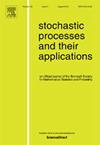Monotonicity properties for Bernoulli percolation on layered graphs— A Markov chain approach
IF 1.1
2区 数学
Q3 STATISTICS & PROBABILITY
引用次数: 0
Abstract
A layered graph is the Cartesian product of a graph with the linear graph , e.g. is the 2D square lattice . For Bernoulli percolation with parameter on one intuitively would expect that for all and . This is reminiscent of the better known bunkbed conjecture. Here we introduce an approach to the above monotonicity conjecture that makes use of a Markov chain building the percolation pattern layer by layer. In case of finite we thus can show that for some the above holds for all and . One might hope that this Markov chain approach could be useful for other problems concerning Bernoulli percolation on layered graphs.
求助全文
约1分钟内获得全文
求助全文
来源期刊

Stochastic Processes and their Applications
数学-统计学与概率论
CiteScore
2.90
自引率
7.10%
发文量
180
审稿时长
23.6 weeks
期刊介绍:
Stochastic Processes and their Applications publishes papers on the theory and applications of stochastic processes. It is concerned with concepts and techniques, and is oriented towards a broad spectrum of mathematical, scientific and engineering interests.
Characterization, structural properties, inference and control of stochastic processes are covered. The journal is exacting and scholarly in its standards. Every effort is made to promote innovation, vitality, and communication between disciplines. All papers are refereed.
 求助内容:
求助内容: 应助结果提醒方式:
应助结果提醒方式:


